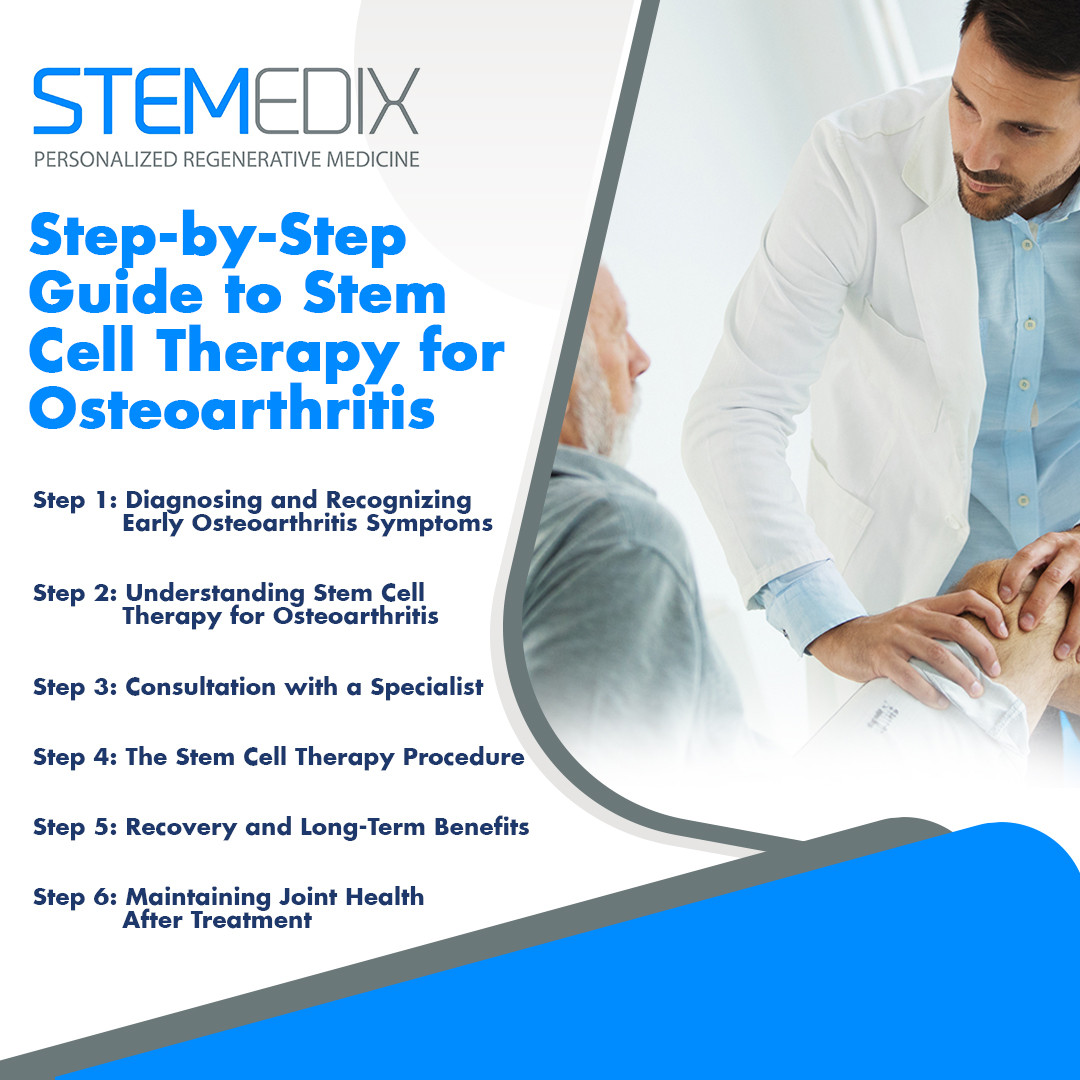From Diagnosis to Healing: A Step-by-Step Guide to Stem Cell Therapy for Osteoarthritis
Saint Petersburg, United States - May 6, 2025 / Stemedix /
Saint Petersburg, FL- Osteoarthritis (OA) affects millions, causing joint pain, stiffness, and swelling. As the cartilage deteriorates, it limits movement and reduces the quality of life. While traditional treatments like pain medications and joint replacements are common, many are turning to stem cell therapy for osteoarthritis. Stemedix, a leader in regenerative medicine, offers innovative stem cell therapy to help patients regain mobility and improve their lives.
Step-by-Step Guide to Stem Cell Therapy for Osteoarthritis
Step 1: Diagnosing and Recognizing Early Osteoarthritis Symptoms
The journey to effective osteoarthritis treatment begins with an accurate diagnosis. At Stemedix, based in Saint Petersburg, FL, physicians conduct a thorough evaluation, asking about symptoms and medical history to identify common signs and symptoms of osteoarthritis, such as joint pain, stiffness, and swelling. A detailed assessment helps pinpoint the condition’s severity.
Imaging tests like X-rays or MRIs are used to examine cartilage damage and joint deterioration to confirm the diagnosis. Early diagnosis is key for successful treatment, as stem cell therapy is most effective before permanent damage occurs. Recognizing early osteoarthritis symptoms can remarkably improve treatment outcomes.
Step 2: Understanding Stem Cell Therapy for Osteoarthritis
Mesenchymal stem cells (MSCs) are used in stem cell therapy, a regenerative treatment for osteoarthritis, to help restore and regenerate damaged joint cartilage. Unlike conventional therapies that primarily manage symptoms, stem cell therapy targets the root cause—cartilage breakdown. MSCs, typically derived from the patient’s own bone marrow or adipose tissue, are injected into affected joints to stimulate tissue repair, reduce inflammation, and promote healing.
Emerging research is also highlighting the role of chondrocytes—the specialized cartilage-forming cells—as a promising component in the future of osteoarthritis treatment. These cells play a critical role in maintaining joint health and are gaining attention for their regenerative potential in advanced therapeutic approaches.
Step 3: Consultation with a Specialist
Seeking advice from a regenerative medicine specialist is essential prior to receiving stem cell therapy. Whether stem cell therapy is the best course of action for your particular osteoarthritis condition will be determined after a thorough consultation. In order to determine the severity of your problem, the doctor will examine you physically, go over your medical history, and assess the findings of any imaging tests at this visit.
Based on this evaluation, the physician will discuss the possible advantages of stem cell therapy for osteoarthritis, go over the process in detail, and answer any queries or worries you may have.
Step 4: The Stem Cell Therapy Procedure
Stem cell therapy for osteoarthritis is minimally invasive, requiring only a small sample of tissue to be collected from either bone marrow or adipose tissue, as well as donor cells. The tissue is then processed in a lab to isolate the mesenchymal stem cells, which are injected directly into the affected joint. This process stimulates cartilage regeneration and reduces inflammation in the joint, helping restore function and alleviate pain.
At Stemedix, we perform ultrasound guided OA procedures and most patients experience minimal discomfort and a short recovery time. After the injection, patients are advised to rest and avoid high-impact activities to allow the stem cells to take effect. Within a few days, most patients can resume their normal daily activities.
Step 5: Recovery and Long-Term Benefits
After the procedure, patients enter a recovery phase where stem cells work to regenerate damaged cartilage. Over the next several months, gradual improvements in pain relief, joint mobility, and overall function can be expected. Following post-treatment instructions and attending follow-up appointments are essential to monitor progress and guarantee excellent healing.
While the healing process takes time, the long-term benefits of stem cell therapy for osteoarthritis are significant. By addressing the root cause, this treatment provides lasting relief and improved joint health. Physical therapy and a healthy lifestyle further enhance recovery outcomes.
Step 6: Maintaining Joint Health After Treatment
Following stem cell therapy for osteoarthritis, it’s essential to maintain joint health through regular low-impact exercise, a balanced diet, and ongoing physical therapy. These practices help preserve joint function, reduce inflammation, and prevent further deterioration of cartilage.
By adopting these healthy habits, patients can make sure that the benefits of stem cell therapy are sustained, allowing them to enjoy a better quality of life without the pain and limitations of osteoarthritis.
Stemedix: A Path to Healing with Stem Cell Therapy for Osteoarthritis
If you’re experiencing the signs and symptoms of osteoarthritis, early intervention is very important for managing the condition and enhancing your quality of life. Stem cell therapy for osteoarthritis offers a non-surgical, regenerative solution that targets damaged cartilage—the root cause of joint pain. At Stemedix, the team is dedicated to providing patients with effective, lasting relief through advanced regenerative medicine.
Contact Stemedix Today
To learn how stem cell therapy can help manage your osteoarthritis symptoms, call (727) 456-8968 or email yourjourney@stemedix.com, schedule your consultation, and start your path to recovery.

Contact Information:
Stemedix
Bayfront Medical Plaza 601 7th Street S. Suite 565
Saint Petersburg, FL 33701
United States
Fred Palmer
https://stemedix.com/
Original Source: https://stemedix.com/from-diagnosis-to-healing-a-step-by-step-guide-to-stem-cell-therapy-for-osteoarthritis/



